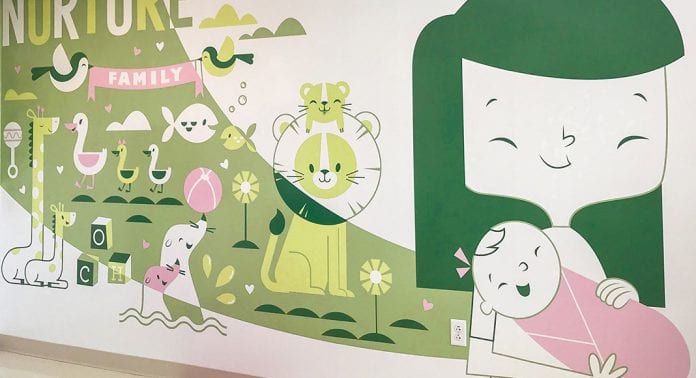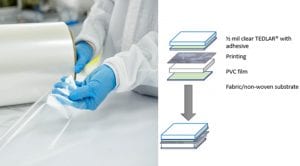
DuPont Tedlar PVF films form unique protective wallcoverings for high-traffic interior surfaces in healthcare environments.
In healthcare environments it is of the utmost importance to keep patient rooms as clean as possible – and yet they experience a constant stream of people coming in and out, performing a variety of tasks, and touching a variety of surfaces, in addition to the patient who spends most of the day living their life in this room. While every effort is made to maintain optimum levels of cleanliness, the patient room is actually a high-traffic area, despite being considered private and highly protected. DuPont™ Tedlar® PVF films can uniquely help protect surfaces that are in this high-traffic environment; in this article we will specifically explore how Tedlar protective wallcoverings can support sterilisation by not sustaining the life of microorganisms like mould, mildew, fungus, and bacteria.
An introduction to Tedlar PVF film
DuPont Tedlar’s versatile polyvinyl fluoride (PVF) films have been protecting surfaces in harsh environments for over 60 years, providing durable, long-lasting protection and timeless aesthetics. From graphics and signage, electronics and photovoltaics, to transportation, aerospace, building and construction, it is used in a range of industries. The PVF films, which are available in a variety of colours and gloss levels, including transparent film, can be applied to the surface of other materials strengthening their durability and making them easier to clean and resistant to chemicals.

Polyvinyl fluoride film is naturally transparent and flexible, enabling its use as a protective wallcovering without addition of any co-resins or plasticisers. It is formulated to provide a desired colour, gloss or special functionality using only inert additives that do not sustain the life of microorganisms like mould, mildew, fungus and bacteria. When sterilisation is required to remove residual microbes, the films have extremely high resistance to degradation by chemicals and disinfectants for even the most rigorous disinfection protocols.
Why choose Tedlar PVF films for healthcare interiors?
Tedlar protective film is proven to meet the unique challenges of dynamic healthcare environments. Tedlar PVF films and wallcoverings do not support the growth of mould, mildew and other fungi, because the films do not contain a nutrient source for these microorganisms. This is demonstrated by two standard tests: ‘Standard practice for determining resistance of synthetic polymeric materials to fungi’ (ASTM G21) and the ‘GREENGUARD Certification Programmme method for measuring microbial resistance from various sources using static environmental chambers’ (UL 2824).
ASTM G21 test
The ASTM G21 test is conducted by placing samples onto the surface of nutrient agar and spraying with a mixed spore suspension of five fungal strains: Aspergillus brasiliensis, Penicilium funiculosum, Chaetomium globosum, Trichoderma virens, and Aureobasidium pullulans. The samples are then incubated for four weeks and the amount of growth on the samples is observed at the end of each week. While the agar contains all the trace nutritional elements necessary to support fungal growth, it lacks a primary carbon source. For the microorganisms to exhibit substantial growth, the material under test would need to provide this nutrient source. Materials are assigned a rating each week and at the conclusion of the test, based on the criteria in Table 1.
| Rating | Observed growth |
| 0 | No growth |
| 1 | Trace of growth (less than 10% coverage) |
| 2 | Light growth (10-30% coverage) |
| 3 | Medium growth (30-60% coverage) |
| 4 | Heavy growth (60-100% coverage) |
Table 1: ASTM G21 rating system for fungal growth
This test was completed on a free-standing white Tedlar PVF film (TWH15BL3) and a DuPont Tedlar Wallcovering. The wallcovering consists of a transparent, protective Tedlar film laminated to a PVC substrate with an adhesive. For each of the four weeks in the test, both samples tested achieved a rating of 1. The materials only exhibited trace growth, indicating that the materials do not contain enough nutrients to sustain substantial growth of fungus, mould and mildew.
UL 2824 Test
The UL 2824 test, which meets the requirements of ASTM D6329, is a part of the annual GreenGuard Certification Programme by UL that recognises products that have superior performance for indoor air quality. This test was run on DuPont Tedlar Wallcovering products as a part of an annual certification. The wallcovering consists of a transparent protective Tedlar PVF film laminated to a decorative PVC substrate using an adhesive. The material was placed into a sterile petri dish, inoculated with a known concentration of Penicillium brevicompactum, and placed into an environmental chamber at 95% humidity at 25°C for three weeks. A positive control sample, which is susceptible to fungal growth, was run in parallel to verify the activity of the microbes.
| Rating | Interpretation | Criteria |
| 4 | Highly resistant to mould growth | Log (CFU) ≤ 2.5 at three weeks, or Log(CFU) < 5.5 with a decrease of at least 0.5 Log(CFU) after three weeks |
| 3 | Resistant to mould growth | 5.5 ≥ Log (CFU) > 2.5 at three weeks |
| 2 | Susceptible to mould growth | 7.5 ≥ Log (CFU) > 5.5 at three weeks |
| 1 | Highly Susceptible to mould growth | Log (CFU) > 7.5 at three weeks |
Table 2: UL 2824 rating criteria
The number of colony-forming units (CFUs) are counted at the beginning and end of the test, and a rating provided based on the criteria shown in Table 2. The DuPont Tedlar Wallcovering achieved the highest rating after the three-week test, indicating that it is highly resistant to mould growth. The number of colony-forming units used to calculate this rating are shown in Table 3 for both the wallcovering and the control material.
| Material | Initial Log (CFU) | Log (CFU) after 3 week incubation | Rating |
| DuPont Tedlar Wallcovering | 2.3 | 1.7 | 4 – Highly resistant to mould growth |
| Control | 2.5 | 7.7 | 1 – Highly susceptible to mould growth |
Table 3: UL 2824 results for DuPont Tedlar Wallcovering
Resistance to bacteria
Bacterial growth is also not supported by Tedlar PVF films which are formulated without plasticisers, processing aids or other additives that can become a nutrient source for microbes. This was demonstrated using ISO 846:2019 Method C: Evaluation of the Action of Microorganisms – Resistance to Bacteria. Several Tedlar PVF films were tested, along with DuPont Tedlar Wallcovering. They are listed in Table 4. Samples were placed on agar that was previously inoculated with Pseudomonas aeruginosa at the desired concentration and covered with additional inoculated agar. Negative control samples were also prepared with non-inoculated agar to facilitate comparison to inoculated samples. The samples and control were incubated for 28 days at 28-30˚C and evaluated for visible evidence of growth.
| Tedlar PVF film or product | Typical end use |
| TTR10BM3 – 1 mil Clear Tedlar Film | Aerospace, Building & Construction |
| TCP10BG3 – 1 mil UV Clear Tedlar Film | Graphics Protection |
| TWH15BL3 – 1.5 mil White Tedlar Film | Architectural Fabrics, Building & Construction |
| TWH10BS1 – 1 mil White Tedlar Film | Building & Construction |
| TWH10SS1 – 1 mil White Tedlar Film | Healthcare, Building Interiors |
| TWH10SS3 – 1 mil White Tedlar Film | Building & Construction |
| DuPont Tedlar Wallcovering Type II | Hospitality, Healthcare, Building & Construction |
Table 4: Tedlar-based products tested via ISO 846:2019 Method C.
The results for all the Tedlar PVF films and DuPont Tedlar Wallcovering showed the same result: there was no growth on or around all five replicate samples and therefore the specimens do not contain nutritive components for this bacterium.
Cleaning and disinfection
While Tedlar PVF films do not contain nutritive components that support the growth of mould, mildew, fungus and bacteria, microbes may still find their way to the surface of the material from the environment. To eliminate these microorganisms from the surface, the surface must be cleaned and disinfected. Tedlar PVF films have outstanding chemical resistance and durability to withstand repeated cleanings with even the harshest chemicals and disinfectants.
| Disinfectant | Rating |
| Oxycide: Hydrogen Peroxide + Peroxyacetic Acid | E |
| Oxivir TB: Hydrogen Peroxide (0.5%) | E |
| Clorox Healthcare bleach solution (10%) | E |
| Virex II 256: Quaternary ammonium | E |
| Hand Sanitiser – 70% IPA | E |
| JF2 Glance: Non-ammoniated | E |
| JF3 Stride Citrus Neutral Cleaner | E |
Table 5: Resistance of Tedlar PVF film to common disinfectant solutions. The ‘E’ rating denotes that there was no perceptible change of appearance or mechanical properties when 2.5ml were deposited on the surface each day for five days and cleaned off only at the end of the test.
The resistance of Tedlar films to several common disinfectants used in a healthcare setting is shown in Table 5. The surface exhibited no cracking, delamination or changes in either colour or gloss after five days of continuous contact. The resistance to growth of mould, mildew, fungus and bacteria is complemented by the outstanding chemical resistance and ease of cleaning and disinfecting. This combines with the durability, versatility and timeless aesthetics to provide unique surface protection with unparalleled performance, indoors and out.
Tedlar in action
John R. Oishei Children’s Hospital, Buffalo, New York
Tedlar is often used in applications that see high human traffic, such as the art installations in patient areas at Buffalo Children’s Hospital in New York. In 2018, many of the protective wallcoverings in common areas of the hospital were redesigned to include inspiring graphics for children and their families. VSP Graphic group collaborated with The Martin Group and Kaleida Health to complete the installation. “After careful consideration, it was the anti-graffiti, resistance to mould and mildew, satin finish and second-to-none durability of Tedlar that made it the best option for a medical environment like this,” Josh Szary, Director of Sales and Marketing for VSP, said. “Children, families, the client and the designers are thrilled with the outcome.”
Omega Medical Center, Newark, Delaware
The Tedlar-protected wallcoverings at the Omega Medical Center have not experienced staining, delamination, peeling or cracking – common issues in other wallcoverings over time – since they were installed over 30 years ago, when the Newark premises was built. Long-term performance and maximising return on investment played an important part in the centre’s business plan, as well as its choice of equipment and furniture; and was a factor in the decision to install Tedlar-protected wallcoverings.
For more information on Tedlar PVF films, please visit www.tedlar.com.
DuPont, the DuPont Oval Logo, and all products, unless otherwise noted, denoted with ™, ℠ or ® are trademarks, service marks or registered trademarks of affiliates of DuPont de Nemours, Inc.
DuPont Advanced Materials
Tweet @DuPont_Tedlar
www.linkedin.com/showcase/dupont-tedlar
www.Tedlar.com










